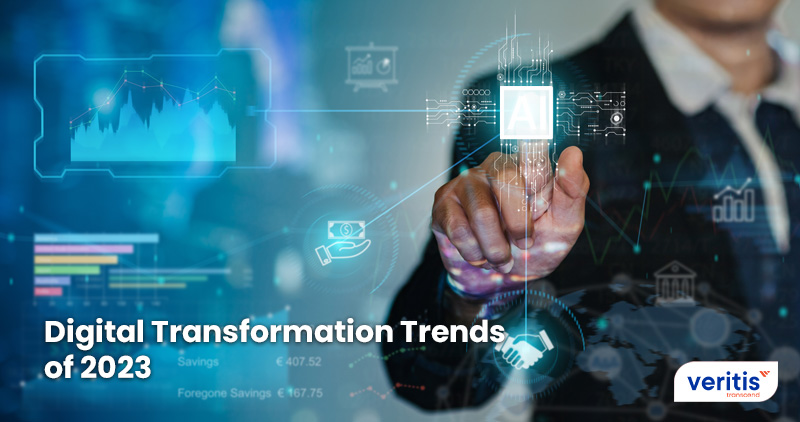
Digital transformation is the need of the hour, as the pandemic has catalyzed digital innovation beyond the expectations of the global populace. While digital solutions propel productivity, creating reliable solutions with little time is arduous. Moreover, developing and maintaining such solutions with legacy infrastructure is even more cumbersome. Legacy systems need to be updated and maintaining them consumes many resources. To overcome these challenges, organizations are opting for digital transformation services.
Digital transformation doesn’t bring the digital infrastructure to your grasp but allows you to reinvent the production culture in your company. If one includes the critical components of a digital transformation strategy, one will reap the benefits of digital transformation.
However, more than reinventing your infrastructure is required as one has to stay abreast of the trends that time brings. So, what does time hold for digital transformation services? Let’s find out.
Digital Transformation Trends

When assessing their 2023 digital transformation strategy, CIOs and IT directors should consider the effects of inflation, a probable recession, and ongoing supply chain issues. These trends imply that IT executives should prioritize 2023 transformation projects that will result in cost reductions, efficiency gains, and risk mitigation.
On the other hand, disruption may result from sluggish progress on customer experience, innovations, and emerging technology. Even companies in sectors that need to catch up in investing in technology, such as heavy industry, medical services, government, and education, should speed up a customer- and growth-focused digital transformation activities. And without further ado, let’s dive into the digital transformation trends likely to come up in 2023.
Useful link: Business Transformation Vs. Digital Transformation: A Thin Line of Difference!
1. Cloud Migration Spike
There are no surprises here as cloud technology is not only here to stay but also to revolutionize the global business arena. Cloud services are being used by businesses increasingly, especially when it comes to cost-cutting, enhancing access, and outsourcing tiresome everyday support duties.
As 2023 matures, it gives way to the digital business transformation trend where businesses shall increasingly integrate their infrastructure with cloud services. Blazing-fast internet connectivity speeds shall support the integration. The latter development shall be realized as companies are pumping in a significant amount of money to build reliable internet connections. This is a welcome digital transformation strategy for underdeveloped countries without excellent internet connectivity, for they can modernize their aging infrastructure.
2. Low-Code Platforms
A development environment known as a low-code platform allows non-technical business users to create, develop, and deploy software applications. In addition, business analysts and other non-technical users may design and develop unique solutions without coding because of the graphical user interface and drag-and-drop features it offers.
Low code platforms’ advantages in terms of time, money, scalability, and risk reduction have led to an increase in their use in recent years. Because companies will be able to judge more rapidly if particular digital goods can thrive in their ecosystem, we believe that as these transformation solutions advance, businesses will embrace them more.
3. ModelOps
While many digital transformation services companies engage in machine learning trials, studies suggest that firms struggle to bring machine learning models to production, analyze their success, and support continuous model upgrades. For instance, 51% of respondents to the “State of ModelOps 2022” survey have conducted early pilots or trials but haven’t yet put them into production.
That statistic is concerning as we approach 2023, when many corporate leaders may curtail spending in unsuccessful experimental data science fields due to a perceived budgetary shortage. However, the survey also shows that although 48% of data science firms struggle to answer questions regarding the ROI of their AI investments, 86% of C-suites do.
MLOps and ModelOps are two techniques and tools that can assist businesses in bridging the gap between putting models into production and proving a profit. ModelOps offers model cataloging, governance, and production monitoring, whereas MLOps, the DevOps for machine learning, promises to streamline model creation and deployment. To decrease the time, expense, and complexity of delivering and sustaining machine learning models in production, IT and data science teams looking to increase their machine learning efforts should consider these platforms.
4. Multi-Cloud Services with AI
Organizations in the digital and technology sectors must also deal with the evolving environment and the challenges of managing hybrid clouds, multi-cloud architectures, and microservices. When it comes to digital transformation, many CIOs are adding new apps and increasing data volumes more quickly than they can retire aging systems. Businesses anticipate high service-level goals and increasing automation from IT Ops supporting these technologies since these apps, integrations, and data lakes are more mission-critical.
Here come AIOps solutions, which are meant to assist IT Ops in utilizing machine learning in all their monitoring tools and observability data. These tools combine the data, use machine learning to correlate warnings, and assist network operations centers (NOCs) in finding root causes more quickly. Most of these solutions integrate with IT service management, collaboration, and other automation tools to initiate conversations and pre-written replies. Additionally, they assist NOCs in creating a single point of access for their databases and applications running on public clouds, data centers, and edge computing.
5. Automation
When examining the expected digital transformation trends, automation is one of the critical components. Business process automation solutions help firms speed up the completion of internal operations by reducing the need for human execution. Although there is a learning curve to get any project off the ground, these technologies can boost productivity, improve the customer experience, and digitize processes in the medium to short term.
More than 80% of business executives claim that they are expanding their use of remote workers and speeding up work process automation. The best way to speed up automation is to choose the appropriate business process automation solutions, which might help deliver faster results with less coding expertise.
6. Customer-Centric Platforms
Customer-centric data and analytics are made possible through a customer data platform that links several applications and databases.
Customer data platforms (CDPs) are tools for organizing customer data, examining consumer patterns, seeing openings for upcoming marketing campaigns, and creating more tailored customer experiences. Customer data systems allow you to consolidate all of the details you have about your clients from many sources into one location. The ability to fully comprehend the consumer is made possible by tools like CDPs, which effectively enable excellent customer experiences. The spike in this trend would a welcome development for digital transformation customer experience teams.
7. Adoption of XaaS or Everything as a Service
A new business model that is gaining popularity is called XaaS. Everything as a Service is an approach to giving users access to software on demand. This paradigm is a development of the SaaS (Software as a Service) concept, which offers internet-based application access.
The trend toward everything as a service (XaaS), which makes everything of a company’s goods and services available as cloud-based subscription services, is one that many businesses are beginning to make in response to this growth. Everything is now digital instead of a dispersed offering, including storage, security, and communications.
Useful link: Understanding XaaS: Everything as a Service and its Advantages
8. Automation
Automation is one of the vital components when examining the trends for the coming digital transformation.
Business process automation solutions help firms speed up the completion of internal operations by reducing the need for human execution. Although there is a learning curve to get any project off the ground, these technologies can boost productivity, improve the customer experience, and digitize processes in the medium to short term.
More than 80% of business executives claim that they are expanding their use of remote workers and speeding up work process automation. The best way to speed up automation is to choose the appropriate business process automation solutions, which might help deliver faster results with less coding expertise. These solutions will revolutionize how your business runs daily when combined with digital signature software.
9. Remote Working
One of the worst things that could have happened to us in the previous two years was the COVID-19 epidemic. Still, on the plus side, it greatly impacted businesses’ decisions to start utilizing or accelerating the use of digital technology.
Businesses realized they could not operate while their workers conducted their business remotely, which prompted a rise in investments in digital software that enables remote collaboration, whether it be team collaboration tools or document collaboration tools. We expect to spend on setting up a virtual workspace that is even better than working from your company’s premises to rise.
Conclusion
Time brings along change and surprises, which roil not only the times but also disruptive changes. The pandemic brought such disruptive changes, and the world is continuing to cope. However, why don’t you take advantage of them instead of coping? Reach out to the Stevie Award winner Veritis and become one with the change by embracing the changing technologies better.
Got Questions? Schedule A Call
Additional Resources:
- All You Need to Know About How Digital Transformation Managed Services Accelerate Business
- Guide to Digital Transformation Technologies and Their Business Impact
- What Technologies Enable Digital Transformation?
- Top Impediments Which Bog Down Digital Transformation
- Digital Transformation: Avoid 8 Most Common Pitfalls